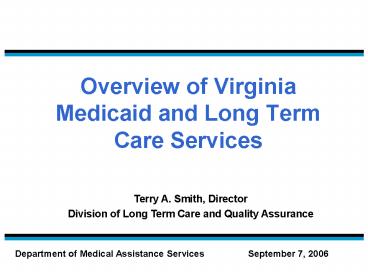Overview of Virginia Medicaid and Long Term Care Services - PowerPoint PPT Presentation
1 / 21
Title:
Overview of Virginia Medicaid and Long Term Care Services
Description:
Division of Long Term Care and Quality Assurance. Department of Medical ... Frank Sinatra. 12. Medicaid Long-Term Care Services. Institutional Services ... – PowerPoint PPT presentation
Number of Views:83
Avg rating:3.0/5.0
Title: Overview of Virginia Medicaid and Long Term Care Services
1
Overview of Virginia Medicaid and Long Term Care
Services
Terry A. Smith, Director Division of Long Term
Care and Quality Assurance
Department of Medical Assistance Services
September 7, 2006
2
Presentation Outline
Overview of Medicaid Trends and
Expenditures Medicaid Long Term Care Services
3
The Faces of Our Customers
- The years teach much
- which the days never knew.
- Ralph Waldo Emerson
4
Medicaid Enrollment Trends
690,898
Notes Average monthly enrollment in the
Virginia Medicaid Program
5
Medical ServicesExpenditure Trends
State Fiscal Year
6
Medicaid Enrollment Trendsby Eligibility Category
Notes Annual unduplicated enrollment in the
Virginia Medicaid program
7
Medicaid Expenditure Trendsby Eligibility
Category
8
Medicaid Enrollment ExpendituresFY 2005
Aged
10
26
Aged
20
Blind Disabled
Adults
13
Blind Disabled
45
57
Children
Adults
9
21
Children
Recipients
Expenditures
9
Medicaid Expenditure TrendsAverage Annual Cost
per Enrollee
10
Presentation Outline
Overview of Medicaid Trends and
Expenditures Medicaid Long Term Care Services
11
- The best is yet to come and wont that be fine?
-
Frank Sinatra
12
Medicaid Long-Term Care Services
- Institutional Services
- Nursing Facility 1st in the nation to have a
pre-admission screening criteria and assessment
developed and implemented - Assisted Living Facilities
- Intermediate Care Facilities for the Mentally
Retarded (ICF/MR) - Durable Medical Equipment
- Specialized Care in Nursing Facilities
- Home Health
- Hospice
- Community Based Services
- Home and Community Based Care Waivers (Seven
Waivers) 2nd in the nation to provide waivers
(1982) - Program of All-Inclusive Care For the Elderly
(PACE)
13
Medicaid Waivers in Virginia
Source CMS 372 reports for FY 2005
14
Two New Waivers Have Been Implemented
- Day Support Waiver for People with Mental
Retardation - Individuals who meet the criteria for ICF/MR
placement and are diagnosed as having mental
retardation and are on the waiting list for the
MR waiver - 300 slots
- Alzheimers Waiver
- Individuals who have a diagnosis of Alzheimers
or related dementia and meet nursing facility
criteria - Are at least 55 years in age (regulations under
revision) - Are receiving an Auxiliary Grant
- Reside in an assisted living facility
- 200 slots
15
Eligibility for Long-Term Care Services
- To be eligible for Medicaid-funded long-term care
services individuals must - Financially qualify for Medicaid and
- Meet specified long-term care criteria according
to a standardized long-term care assessment
instrument - Uniform Assessment Instrument (UAI) for nursing
facility level of care (includes all
home-and-community based) - Level of Functioning (LOF) Survey for ICF/MR
level of care
16
Medicaid Plays an Essential Role as the Primary
Funding Source for Long Term Care
- In 2004, Medicaid accounted for 47 of national
long-term care spendingthe single largest source
of financing for long term care. - Medicare and private health insurance provide
limited coverage - Medicaid paid for 67 of institutional care.
- Eighty percent of the elderly with long term care
needs receive help solely from family and friends
who are not paid for these efforts - In FY 2005, more than 25,000 Virginians received
care in a nursing facility and more than 19,000
received long term care services in the
community.
17
Percentage of Expenditures by Type of LTC in
Virginia(total about 1.2 billion)
Waivers
(30)
(51)
Nursing Facilities
(19)
ICF/MR
The Statistical Record of the Virginia Medicaid
Program, SFY 2004
18
The Future of Long Term Care Several
CommunitiesAre Interested in the PACE Model
- Virginia has had one Pre-PACE site for several
years. Sentara, which serves the Tidewater area,
is moving to make this a full PACE site by late
2006/early 2007. - Other communities interested in providing a PACE
program - Lynchburg
- Charlottesville
- Richmond (newest area of interest)
- Northern Virginia
- Hampton
- Tazewell
- Big Stone Gap
- To this end, Governor Kaine submitted a budget
amendment to provide 1.5 million to at least six
sites in start up funds.
19
The Future of Long Term Care Integration of
Acute and Long Term Care Services
- ADVANTAGES FOR OUR CUSTOMERS
- For our seniorsit delays institutionalization
and maintains them in their home and community
settings. For persons with disabilitiesit
maintains and/or delays the progression of the
disability continuum. - A care coordinator serves as a single point of
contact for customers and their caregivers for
all covered health and long-term care services. - There is flexibility in utilizing the appropriate
mix of services home health, personal
assistance, adult day care---not found in a
fragmented fee for service program. The lowest
cost service at the optimal level can be
provided. - Support services are provided in a decisive
manner to avoid hospital admission, ensure
disease state management compliance, and create
opportunities for successful discharge planning.
20
The Future of Long Term Care Integration of
Acute and Long Term Care Services
- ADVANTAGES FOR THE COMMONWEALTH
- Streamline administration
- Provider performance levels are monitored
- Fraud and abuse mechanisms are in place
- Provide preventive services to the elderly and
persons with disabilities to delay or avoid the
need for more costly and more restrictive long
term care services - Coordinate Medicare and Medicaid services/funding
- Stable and predictable state expenditures
21
The Future of Long-Term Care
- Envision a world that values age, a nation that
embraces agea Commonwealth that honors age.































